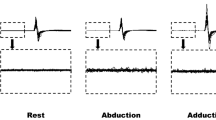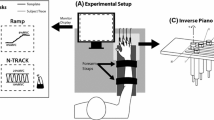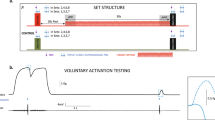Abstract
We investigated the changes in finger coordination and in finger force responses to transcranial magnetic stimulation (TMS) applied over the motor cortex associated with a single practice session of an accurate ramp force production task. Subjects pressed with their index, middle and ring fingers onto three force transducers fixed to a rigid platform that was balanced on a narrow pivot under the middle finger. The task was to produce a smoothly increasing ramp of total force from 0 to 25 N over 4 s following a visual target. Subjects performed three brief series of trials without TMS (12 trials each) in the beginning, in the middle, and in the end of the experiment. The main part of the experiment involved 173 trials, and in each of them at random times in the ramp a suprathreshold TMS pulse was applied over the hand area of the contralateral motor cortex in order to evoke a twitch in the finger flexor muscles. At the end of the experiment the subjects also performed 12 constant force production trials, and TMS was unexpectedly applied in each trial. During the ramp force trials the amplitude of the response to TMS was largely independent of the force exerted at the time of stimulation, whereas in static holding trials the amplitude of the response increased with higher levels of background contraction. Over time subjects improved their overall tracking performance: the variance of the force trajectory (VarFTOT), as computed over sets of unperturbed trials, declined by 60% after the first 100 trials, but there was little additional improvement after the second 100 trials. Variance in the force finger space related to the total moment with respect to the pivot also showed a decline during the first half of practice and minimal further changes during the second half. In contrast, finger force variance that did not affect either total force or total moment showed no changes after the first 100 trials and a decline during the second 100 trials. This variance component quantified per finger was significantly larger than those related to the total force and total moment. The mean size of the TMS-induced phasic force increment decreased by 12% over the course of the 200 trials. The forces evoked in the index and ring fingers gradually became more equal, reducing the total moment with respect to the pivot and improving balance. We speculate that development of a relatively low twitch force with low total moment on the pivot made it easier for subjects to continue tracking after the TMS pulse. Such changes could well be correlated with the degree of corticospinal involvement in the task. The results suggest task specific, practice-related plastic changes in neural structures involved in the responses to TMS.









Similar content being viewed by others
References
Aimonetti JM, Nielsen JB (2002) Cortical excitability and motor task in man: an investigation of the wrist extensor motor area. Exp Brain Res 143:431–439
Bennett KM, Lemon RN (1996) Corticomotoneuronal contribution to the fractionation of muscle activity during precision grip in monkey. J Neurophysiol 75:1826–1842
Bernstein NA (1967) The coordination and regulation of movements. Pergamon, London
Carroll TJ, Riek S, Carson RG (2001) Corticospinal responses to motor training revealed by transcranial magnetic stimulation. Exerc Sport Sci Rev 29:54–59
Classen J, Liepert J, Wise SP, Hallett M, Cohen LG (1998) Rapid plasticity of human cortical movement representation induced by practice. J Neurophysiol 79:1117–1123
Datta AK, Harrison LM, Stephens JA (1989) Task-dependent changes in the size of response to magnetic brain stimulation in human first dorsal interosseous muscle. J Physiol (Lond) 418:13–23
Domkin D, Laczko J, Jaric S, Johansson H, Latash ML (2002) Structure of joint variability in bimanual pointing tasks. Exp Brain Res 143:11–23
Flament D, Goldsmith P, Buckley CJ, Lemon RN (1993) Task dependence of responses in 1st dorsal interosseous muscle to magnetic brain stimulation in man. J Physiol (Lond) 464:361–378
Hasegawa Y, Kasai T, Kinoshita H, Yahagi S (2001) Modulation of a motor evoked response to transcranial magnetic stimulation by the activity level of the first dorsal interosseous muscle in humans when grasping a stationary object with different grip widths. Neurosci Lett 299:1–4
Kiers L, Clouston P, Chiappa KH, Cros D (1995) Assessment of cortical motor output: compound muscle action potential versus twitch force recording. Electroencephal Clin Neurophysiol 97:131–139
Latash ML, Li Z-M, Zatsiorsky VM (1998) A principle of error compensation studied within a task of force production by a redundant set of fingers. Exp Brain Res 122:131–138
Latash ML, Scholz JF, Danion F, Schöner G (2001) Structure of motor variability in marginally redundant multi-finger force production tasks. Exp Brain Res 141:153–165
Latash ML, Scholz JP, Schöner G (2002a) Motor control strategies revealed in the structure of motor variability. Exerc Sport Sci Rev 30:26–31
Latash ML, Scholz JF, Danion F, Schöner G (2002b) Finger coordination during discrete and oscillatory force production tasks. Exp Brain Res 146:419–432
Lemon RN, Johansson RS, Westling G (1995) Corticospinal control during reach, grasp and precision lift in man. J Neurosci 15:6145–6156
Li Z-M, Latash ML, Zatsiorsky VM (1998) Force sharing among fingers as a model of the redundancy problem. Exp Brain Res 119:276–286
Lim CL, Yiannikas C (1992) Motor evoked potentials: a new method of controlled facilitation using quantitative surface EMG. Electroencephalog Clin Neurophysiol 85:38–41
Muir RB, Lemon RN (1993) Corticospinal neurons with a special role in precision grip. Brain Res 261:312–316
Pascual-Leone A (2001) The brain that plays music and is changed by it. Ann N Y Acad Sci 930:315–329
Pascual-Leone A, Dang N, Cohen LG, Brasil-Neto JP, Cammarota A, Hallett M (1995) Modulation of muscle responses evoked by transcranial magnetic stimulation during the acquisition of new fine motor skills. J Neurophysiol 74:1037–1045
Ravnborg M, Blinkenberg M, Dahl K (1991) Standardization of facilitation of compound muscle action potentials evoked by magnetic stimulation of the cortex. Electroencephalog Clin Neurophysiol 81:195–201
Scholz JP, Schöner G (1999) The uncontrolled manifold concept: identifying control variables for a functional task. Exp Brain Res 126:289–306
Scholz JP, Schöner G, Latash ML (2000) Identifying the control structure of multijoint coordination during pistol shooting. Exp Brain Res 135:382–404
Scholz JP, Danion F, Latash ML, Schöner G (2002) Understanding finger coordination through analysis of the structure of force variability. Biol Cybern 86:29–39
Shadmehr R, Holcomb HH (1997) Neural correlates of motor memory consolidation. Science 277:821–825
Shinohara M, Li S, Kang N, Zatsiorsky VM, Latash ML (2003) Effects of age and gender on finger coordination in MVC and submaximal force-matching tasks. J Appl Physiol 94:259–270
Slifkin AB, Newell KM (1999) Noise, information transmission, and force variability. J Exp Psychol Hum Percept Perform 25:837–851
Todorov E, Jordan MI (2002) Optimal feedback control as a theory of motor coordination. Nat Neurosci 5:1226–1235
Toni I, Krams M, Turner R, Passingham R (1998) The time course of changes during motor sequence learning: a whole brain fMRI study. Neuroimage 8:50–61
Vereijken B, van Emmerick REA, Whiting HTA, Newell KM (1992) Free(z)ing degrees of freedom in skill acquisition. J Mot Behav 24:133–142
Zatsiorsky VM, Li Z-M, Latash ML (1998) Coordinated force production in multi-finger tasks. Finger interaction, enslaving effects, and neural network modeling. Biol Cybern 79:139–150
Acknowledgements
The study was in part supported by grants NS-35032 and AG-018751 from the National Institutes of Health, USA. We thank the anonymous reviewers for many productive critical comments.
Author information
Authors and Affiliations
Corresponding author
Rights and permissions
About this article
Cite this article
Latash, M.L., Yarrow, K. & Rothwell, J.C. Changes in finger coordination and responses to single pulse TMS of motor cortex during practice of a multifinger force production task. Exp Brain Res 151, 60–71 (2003). https://doi.org/10.1007/s00221-003-1480-y
Received:
Accepted:
Published:
Issue Date:
DOI: https://doi.org/10.1007/s00221-003-1480-y




